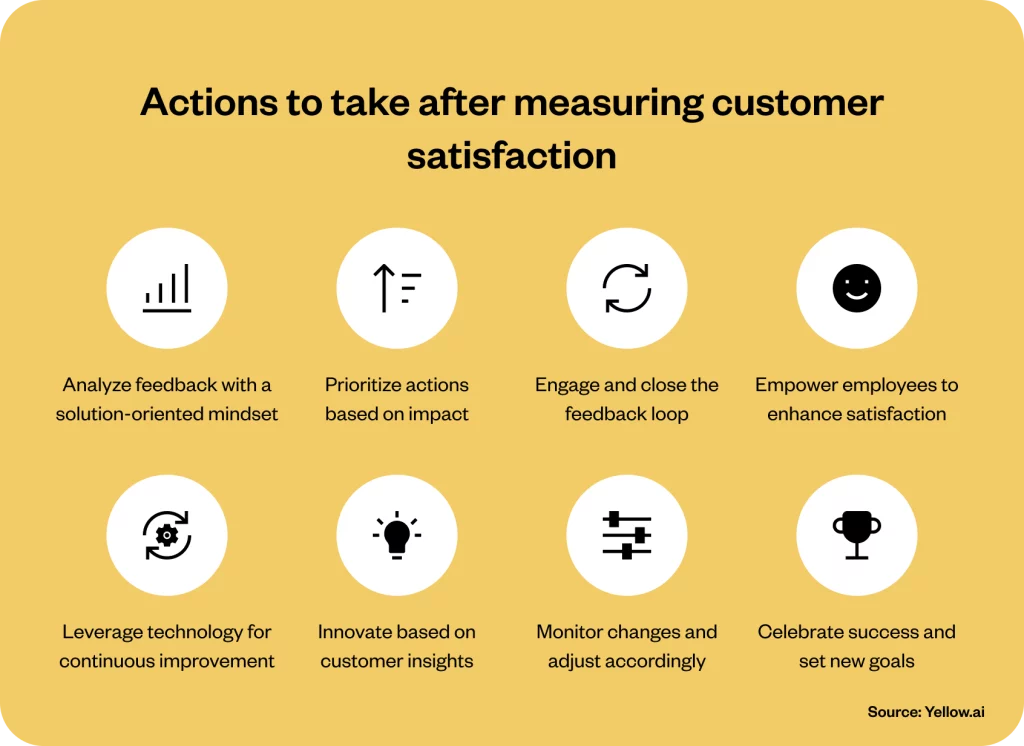Executive summary
Unlocking the secrets to customer satisfaction hinges on mastering a few crucial metrics. This blog slices through the complexity, offering a straightforward guide on measuring what truly matters to your customers. Diving into key performance indicators (KPIs), innovative non-survey methods, and the pivotal customer satisfaction KPI, we pave a clear path for businesses eager to understand and elevate their customer service game.
Introduction
In a world where every business claims to be the best friend of its customer, a staggering reality check from a survey shows a chasm between perception and reality: 80% of companies believe they deliver superior service, yet a mere 8% of customers echo that sentiment. This disconnect not only whispers but screams the need for a precise, multi-dimensional approach to measuring customer satisfaction. Why? Knowing your customers’ happiness is the bedrock of transforming them into champions of your brand.
Step into the world of customer satisfaction metrics, where data speaks louder than assumptions. These aren’t just numbers; they’re the whispers of your customers’ actual experiences translated into actionable insights. With a range of tools at your disposal, from AI-powered analytics to old-school feedback forms, measuring satisfaction has evolved from a hit-or-miss affair to a fine art. In this blog, we unfold the essential metrics that paint the complete picture, ensuring your strategy moves beyond mere satisfaction to fostering loyal advocates for your brand.
Read on to transform data into your strategic advantage, making every customer interaction count and matter.
Related must-reads:
- Customer service automation – A full guide
- 10 Types of customer service you should know
- Customer service software: How to select the best one
- Good customer service: Ways to deliver [+10 Examples]
Understanding customer satisfaction
Customer satisfaction, at its core, is the litmus test for measuring how effectively a business fulfills its customers’ needs, desires, and expectations. It’s the bridge between what customers envision and what they actually experience. It spans the entirety of their journey, from the initial contact through the after-sales support. Besides just the end product, this metric encapsulates every interaction, be it through customer service, the quality of communication, or the ease of navigating your services. It is the comprehensive scorecard reflecting how your business is perceived from the outside in.
Understanding customer satisfaction is crucial for businesses because it is like getting the inside scoop on what makes your customers tick. It’s more than a metric; it’s a mirror reflecting the effectiveness of your entire operation from your customer’s viewpoint. In today’s competitive landscape, where choices are endless and patience thin, getting customer satisfaction right means going above and beyond expectations. It is about making every interaction count, ensuring that customers become the advocates for your brand.
Why should you measure customer satisfaction?
Measuring customer satisfaction is crucial, and here’s why:

1. Boosting loyalty and wallet-share
Did you know that customers with a strong bond to a brand are less swayed by price tags? It’s true. This emotional connection, known as attitudinal loyalty, turns customers into your most powerful advocates. They’re the ones more likely to stick around, spend more, and sing your praises to others. In absolute numbers, achieving this level of loyalty means you’re not just making a sale; you’re securing a partnership that pays dividends over time.
2. Cutting costs, growing revenue
Here’s a straightforward equation: Happy customers = lower costs + higher revenue. As satisfaction levels rise, the effort and expense of retaining customers drop significantly. But there’s more. A satisfied customer is often willing to pay more for the reassurance of quality and service they trust.
A Merkle study shows that a whopping 66% of consumers rated experience over price in their purchasing decisions. It underscores the power of a positive customer experience in driving financial success.
3. Navigating the business compass
Flying blind is no way to run a business. Without regularly measuring customer satisfaction, you’re missing out on essential insights that could steer your company toward more significant success. Regular feedback acts as your compass, highlighting what works, what doesn’t, and where there’s room for improvement. This ongoing dialogue with your customers ensures your products and services evolve in step with their needs and expectations. It keeps you relevant and in demand.
4. Sustaining excellence
Consistent measurement of customer satisfaction doesn’t just spotlight areas for improvement; it reinforces what you’re doing right. Understanding the ‘why’ behind your success enables you to double down on those strategies, ensuring that your brand exceeds customer expectations. This commitment to excellence is what sets market leaders apart. It turns casual buyers into lifelong fans.
How to measure customer satisfaction?
Understanding the pulse of your customers is essential for your business’s growth and sustainability. In the journey of enhancing customer satisfaction, your toolkit should be diverse and robust. Here’s a breakdown of 12 strategic steps to gauge customer satisfaction effectively.

1. Implement customer satisfaction surveys for direct feedback
Customer satisfaction surveys are the direct line to your customer’s thoughts and feelings about their experience with your product or service. These surveys can vary in form, from in-app pop-ups post-interaction to email questionnaires sent after a purchase. The key is to ask specific, relevant questions that gauge the customer’s satisfaction accurately.
Surveys offer tangible data that can highlight areas for improvement and celebrate successes. For instance, a cafe might discover through surveys that customers love their coffee but wish for more pastry options. It will guide their next menu update. Ensure surveys are concise to encourage completion, and consider offering an incentive for participation.
Related read: Voice of the Customer: Effective feedback methods
2. Monitor Net Promoter Score (NPS) to gauge loyalty and satisfaction
NPS measures customer loyalty by asking how likely they are to recommend your business to others. Respondents are categorized as Promoters, Passives, or Detractors. That provides a clear picture of your company’s performance in the eyes of your customers.
A high NPS indicates strong customer loyalty and satisfaction. For example, a software company with a high NPS can infer that its users find significant value in its product. To effectively use NPS, follow up with both Promoters and Detractors to understand their feedback deeply and make informed adjustments.
Related read: Net Promoter Score (NPS): The definitive guide for businesses
3. Analyze the Customer Satisfaction Score (CSAT) for immediate reactions
CSAT focuses on short-term satisfaction, asking customers to rate their experience immediately after an interaction. It’s typically measured with a simple question about how satisfied customers were with a service or purchase.
CSAT provides a snapshot of customer feelings. It helps businesses react swiftly to feedback. For example, a retail store receiving low CSAT scores on checkout speed can implement additional training for staff to address the issue. Regularly monitor CSAT scores to keep a pulse on customer sentiment.
4. Utilize Customer Effort Score (CES) to measure service ease
CES assesses the ease with which customers can get their issues resolved or complete a desired action. It’s a critical metric for understanding the friction points in the customer journey.
Lower effort scores signify smoother experiences, leading to higher satisfaction and loyalty. For instance, a telecom company reducing the steps to pay a bill online would likely see an improvement in its CES. Simplify processes and eliminate unnecessary steps for better CES results.
Related read: What is Customer Effort Score and how to improve CES?
5. Track social media sentiment for unfiltered customer opinions
Social media platforms are where customers freely express their opinions. Monitoring these channels provides real-time insights into customer sentiment, both positive and negative.
Analyzing social media sentiment can reveal trends in customer perception. A cosmetic brand might notice increased positive sentiment after launching a new product line, signaling a successful launch. Employ social listening tools to track and analyze sentiment efficiently.
Related read: An effective how-to guide for social media customer service
6. Conduct customer interviews for in-depth insights
Direct conversations with customers can uncover detailed feedback that surveys might miss. Interviews allow for a deeper exploration of customer experiences, preferences, and suggestions.
Use interviews to explore the nuances of customer satisfaction and dissatisfaction. A technology firm could discover through interviews that clients desire more customizable features, guiding product development. Choose a representative sample of customers for interviews to ensure diverse perspectives.
7. Review customer support ticket trends for recurring issues
Analyzing patterns in customer support tickets can identify common problems and areas needing attention. This method helps prioritize fixes based on actual customer experiences.
Identifying and addressing recurring issues can significantly improve customer satisfaction. An online retailer noticing frequent complaints about shipping delays might work with logistics partners to find solutions. Implement a system for categorizing and reviewing support tickets regularly.
8. Assess customer churn rate for satisfaction and retention insights
Customer churn rate measures how many customers stop using your service over a certain period. It’s a vital indicator of long-term satisfaction and loyalty.
A lower churn rate suggests higher customer satisfaction. A subscription service with decreasing churn might infer that recent improvements are resonating with customers. Analyze exit feedback from churned customers to identify specific areas for improvement.
9. Analyze Customer Lifetime Value (CLV) for long-term satisfaction
CLV predicts the total value a customer will bring to your company over their entire relationship. High CLV indicates strong customer satisfaction and loyalty.
Increasing customer lifetime value (CLV) often involves enhancing customer satisfaction. For instance, a fitness center could offer personalized workout plans to increase member engagement and retention. Focus on personalized experiences and quality service to boost CLV.
10. Employ mystery shopping to evaluate consistency and experience
Mystery shoppers experience and evaluate your service from a customer’s perspective. This method assesses staff performance, operational efficiency, and overall customer experience.
Use mystery shopping to identify training opportunities and operational improvements. A restaurant might learn from a mystery shopper that service is slow during peak hours, prompting a staff schedule adjustment. Ensure mystery shoppers mirror actual customer profiles for accurate assessments.
Related read: Everyone deserves AI-enabled personal shopping assistants
11. Monitor online reviews and ratings for public perception
Online reviews and ratings provide a wealth of data on customer satisfaction and areas for improvement. They are a public testament to your company’s strengths and weaknesses.
Positive reviews can attract new customers, while negative reviews offer opportunities for improvement. A hotel responding thoughtfully to negative reviews and addressing the concerns raised can turn potential negatives into positives. Actively encourage satisfied customers to leave reviews to balance perspectives.
12. Engage in continuous feedback loops for real-time insights
Establishing mechanisms for constant, real-time feedback allows businesses to stay agile and responsive to customer needs. This approach fosters an ongoing dialogue with customers, making them feel heard and valued.
Continuous feedback loops can lead to rapid improvements in customer satisfaction. An app developer could use real-time feedback to quickly fix bugs or add requested features, enhancing user satisfaction. Implement accessible feedback channels and respond promptly to demonstrate your commitment to customer satisfaction.
Actions to take after measuring customer satisfaction
Measuring customer satisfaction is akin to mapping the terrain of your customers’ experiences and expectations. However, the journey doesn’t end with the collection of this valuable data. The true challenge (and opportunity) lies in taking strategic actions based on these insights. The goal is to transform feedback into fuel for growth, improvement, and, ultimately, higher satisfaction levels. Let’s explore the actionable strategies that can help businesses not just listen but also respond effectively to their customers.

1. Analyze feedback with a solution-oriented mindset
Once you’ve gathered customer feedback, sift through it with an eye for patterns and recurrent themes. It isn’t about tallying up scores but understanding the why behind them. For instance, if customers frequently cite long wait times, it’s not just a queue issue; it’s about valuing their time. Implementing a callback feature or enhancing your online self-service options can be a game-changer. The key is to look for solutions that address the root cause, not just the symptoms.
2. Prioritize actions based on impact
Not all feedback will require immediate action, nor will all actions have the same impact on customer satisfaction. Use the insights to prioritize initiatives that offer the most significant benefit to your customers. If your NPS scores indicate that reliability is a concern, focusing on improving product quality or service uptime can have a profound effect on overall satisfaction. It’s about allocating resources to where they can make the most significant difference.
3. Engage and close the feedback loop
Customers who take the time to share their feedback should be acknowledged. More importantly, they want to know that their voice has led to change. Communicate openly about the steps you’re taking in response to feedback. A simple follow-up email detailing the actions you’re implementing can turn a detractor into a promoter. It demonstrates that you’re not just listening but actively improving.
4. Empower employees to enhance satisfaction
Your frontline staff are the custodians of your customer satisfaction. Equipping them with the right tools and training based on customer feedback empowers them to deliver exceptional service. For instance, if feedback suggests that customers find your buying process complicated, training your team to guide customers through it or simplifying the process itself can enhance satisfaction. Remember, empowered employees create satisfied customers.
Related read: Employee experience: A complete guide for HR
5. Leverage technology for continuous improvement
Incorporate technology solutions that allow for real-time feedback and swift adjustments. Implementing chatbots for immediate responses or using AI for sentiment analysis can provide ongoing insights into customer satisfaction levels. A retail business, for example, could use chatbots to handle common queries, freeing up human agents to tackle more complex issues, thereby improving the overall customer experience.
6. Innovate based on customer insights
Use customer satisfaction data as a springboard for innovation. Perhaps customers are seeking features in your product that you haven’t considered, or there’s a demand for a new service that complements your existing offerings. For a tech company, this might mean developing a new app based on customer suggestions for easier access to your services. Innovation driven by customer feedback not only meets their current needs but can also anticipate future desires.
7. Monitor changes and adjust accordingly
The market and your customers’ expectations will continue to evolve, and so should your strategies for improving customer satisfaction. Regularly review the impact of the actions you’ve taken and be prepared to adjust your approach as needed. It’s a continuous cycle of improvement, measurement, and adaptation.
8. Celebrate success and set new goals
When feedback leads to positive outcomes, celebrate these milestones with your team and your customers. It reinforces the value of listening and responding to feedback. Then, set new goals for further improvements. Continuous improvement is an endless journey, but each step forward enhances your relationship with your customers and drives your business’s success.
Begin your journey to measuring customer satisfaction effectively with Yellow.ai.
Navigating the labyrinth of customer satisfaction metrics might seem daunting, but it’s a journey worth embarking on. And what better way to streamline this journey than with Yellow.ai by your side? Yellow.ai is about unlocking the full potential of customer insights and satisfaction through cutting-edge AI technology.
At the heart of measuring customer satisfaction is understanding and responding to your customer’s needs, preferences, and feedback. Here’s how Yellow.ai stands out as your ally in this mission:
Real-time sentiment analysis: Yellow.ai’s advanced sentiment analysis tools go beyond mere words, interpreting the emotions behind customer interactions. It allows businesses to gauge satisfaction levels in real-time. As a result, businesses can identify both delighted customers and those who need extra attention.
Automated surveys and feedback loops: Deploy instant, AI-powered surveys across various channels with Yellow.ai. Capture immediate customer reactions post-interaction, offering invaluable insights into your service’s impact on customer satisfaction.
Personalized customer experiences: Tailor every customer interaction based on historical data and preferences. Yellow.ai’s AI-driven personalization enhances satisfaction by making customers feel understood and valued.
Seamless integration with CRM systems: Integrate Yellow.ai chatbots with your existing CRM to provide a unified view of customer satisfaction metrics. This integration enables a more coherent strategy for improving customer experiences based on concrete data.
Proactive customer support: Leverage Yellow.ai’s chatbots for 24/7 support, addressing queries and concerns promptly. Besides reducing customer effort, it significantly boosts overall satisfaction.
AI-driven insights and analytics: Harness the power of AI to analyze trends, feedback, and support ticket data. Yellow.ai offers actionable insights that can help refine strategies for enhancing customer satisfaction.
Ready to transform your approach to measuring and enhancing customer satisfaction? Book a demo with Yellow.ai today and discover the difference innovative AI technology can make in elevating your customer service experience.
The final thought: Commencing on a future of enhanced customer satisfaction
Let’s pause and reflect as we draw the curtains on our exploration of measuring customer satisfaction. The journey doesn’t end with collecting feedback or crunching numbers. It’s about fostering an environment where every piece of feedback serves as a stepping stone towards unparalleled customer experiences. In this dynamic business landscape, understanding and improving customer satisfaction is a culture that needs to be nurtured.
With the right tools and technology, such as Yellow.ai, businesses have the opportunity to measure and significantly enhance customer satisfaction. It’s about making every interaction count, turning insights into action, and continuously evolving with your customers’ needs. As we move forward, let’s embrace these challenges and opportunities with the assurance that in the quest for customer satisfaction, we are not alone. Yellow.ai is here to guide, support, and transform our journey into one marked by success, innovation, and, most importantly, happy customers.

















